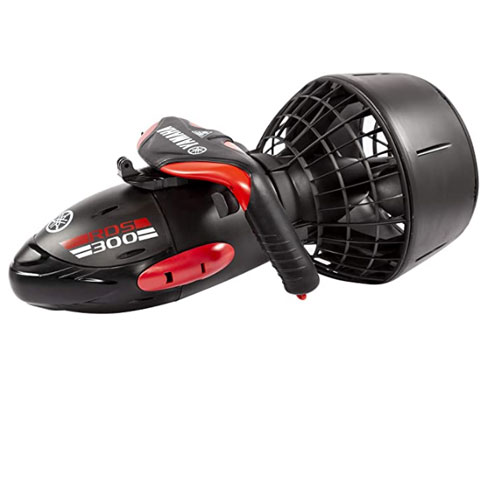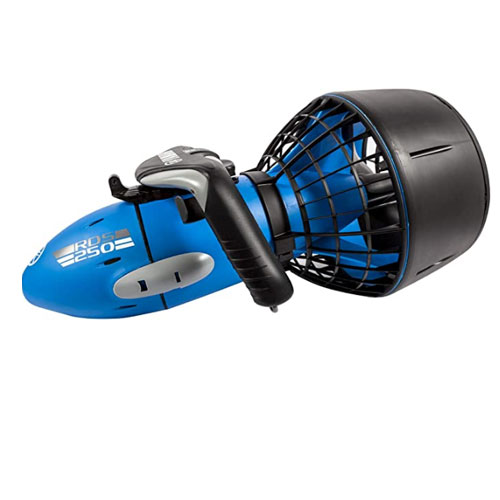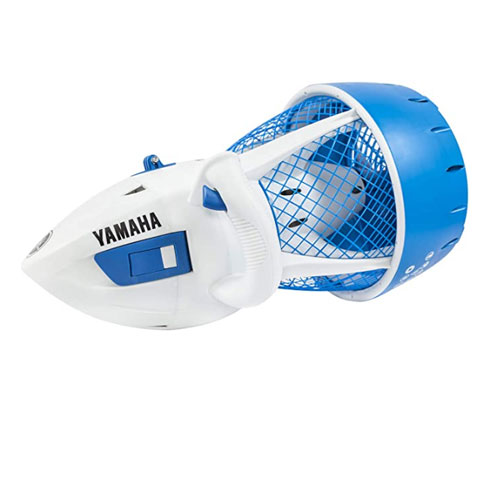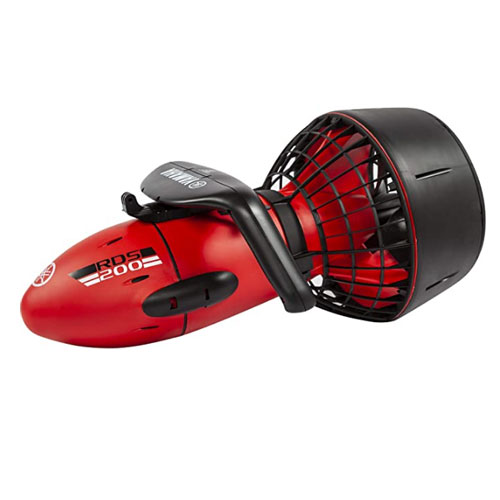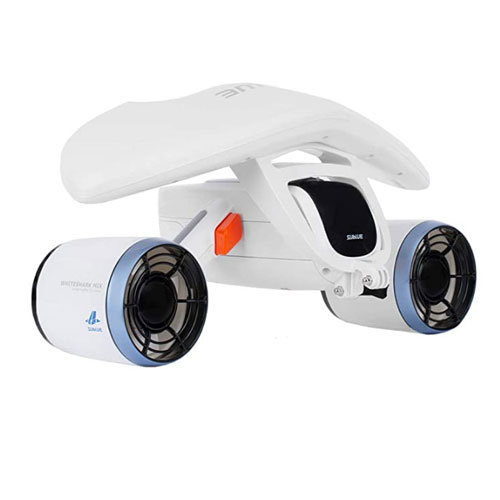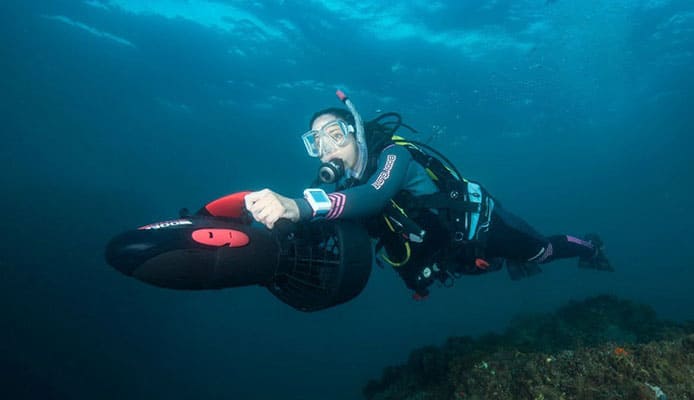
Underwater scooters are becoming very popular. Also known as Diver Propulsion Vehicles or DPV, advancements in technology have led to greatly lower entry prices for these devices. In the past, a Diver Propulsion Vehicle was a considerable investment for a diver. Few divers could justify the cost.
The lower prices not only allow more divers to be able to afford an underwater scooter, but it also extends the users to snorkelers, as well. Some manufacturers are even making models that are designed for children.
Commercial diver propulsion vehicles are still a considerable investment, however, recreational underwater scooters are affordable. Which one is the best underwater scooter on the market though? Here we pick the five best sea scooters to see which one stands out.
OUR TOP PICK
Yamaha RDS300 SeaScooter
- Stand Out Features - Why We Love It
- Rated for depths of 100 feet
- Fastest sea scooter at 3 miles per hour
- Impact-resistant hull
EDITORS CHOICE
Yamaha RDS250 Seascootter
- Stand Out Features - Why We Love It
- 2 hours of run time
- Buoyancy control chamber
- 100-foot depth rating
BEST VALUE
Yamaha Explorer Seascooter Camera Mount
- Stand Out Features - Why We Love It
- Great for Snorkeling and shallow Dives
- Lightweight
- Perfect for children
YAMAHA RDS 200 Seascooter Camera Mount Recreational Dive
- Stand Out Features - Why We Love It
- Depth of up to 65 feet
- Buoyancy regulator
- Lightweight at 13 pounds
Sublue WhiteShark Mix Underwater Scooter
- Stand Out Features - Why We Love It
- Dual motors
- 130 feet depth rated
- Weighs under 6.5 pounds
- Underwater scooters containing “life indicators” should be prioritized, as the user can quickly recognize a dying battery - reducing the risk of potential danger.
- Buying and using carbon fiber propellers reduces the scooter’s weight, making it easier and more accessible to transport.
- If you’re on a budget, buying your scooter second-hand can drastically reduce the overall price of an underwater scooter. Just be sure to have it checked out by a professional before making the purchase.
![]()
Scuba Diving Expert
How To Choose The Best Underwater Scooter /Diver Propulsion Vehicles ( DPV)– Buying Guide
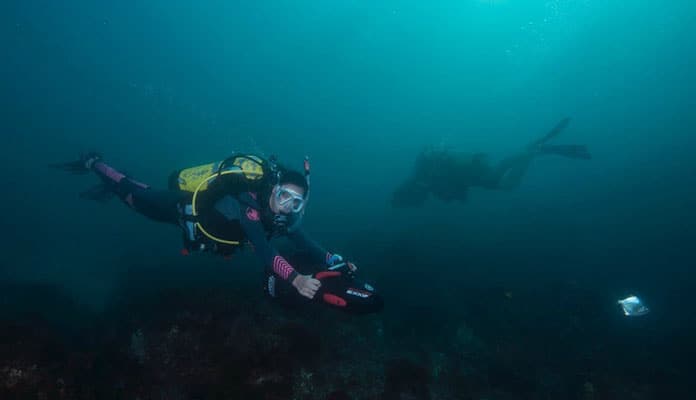
How Will You Use Your Underwater Scooter?
Before you invest in an underwater scooter, you need to determine how you will use it. If you’re using it to go snorkeling, then any of these devices will be more than good enough. You will not need the depth that some more expensive models have. On the other hand, a diver will find it more practical to get a Diver Propulsion Vehicles (DPV) that has a depth limit in line with their current or planned certification limits.
There are other things to consider, however, as you want to ensure that you have enough battery life to be able to get back to shore or your boat. Snorkelers, normally, do not range as far as divers, so run time is more important to a diver.
There are much more expensive models on the market geared to specific diving tasks and environments. The models reviewed above, are for the snorkeler and the recreational diver.
What Is Your Maximum Depth
This is an important consideration that was mentioned above but deserves a more in-depth look. Unless you’re a certified diver, there isn’t much of a need for a scooter that goes deep into the water. A depth of 30 feet is more than enough for non-divers and that is the depth that you will find on many underwater scooters.
However, most scuba divers dive deeper than 30 feet. An underwater scooter with a 30 foot (ca. 9 m) range would get little use from most divers. Open water divers are certified to dive to 60 feet (ca. 18 m) and dives to that depth are the most common. Buying a DPV rated for this depth would make the most sense. There are Diver Propulsion Vehicles models that can go a lot further though such as the RDS300 which will dive to around 100 feet. This is the deepest limit for an Advanced Open Water Diver, who is not also certified as a deep diver. Deep divers can dive to 130 feet.
Battery Life and Power
How important the battery life is will depend on your usage. If you’re going to be diving far from the shore or an inflatable boat, then you’ll want a scooter that has up to 2 hours of battery life. If you are snorkeling or doing shallow dives, a battery life of 1.5 hours should be more than enough to have a great day. You can always recharge a battery or swap batteries if you wish for an extended day
How Buoyant Is It?
An item is neutrally buoyant when it neither sinks nor floats up when let go in the water. An item positively buoyant will rise towards the surface, while a negative item will sink. Negative and positive buoyancy is measured in pounds. The higher the weight the faster the item will move in the proper direction. The water you are is a factor that impacts buoyancy. Saltwater will make items more buoyant than freshwater.
Most of the scooters handle this problem without having to have additional controls, but the more premium models will allow you to change your buoyancy which will make your ride more comfortable. Most of these scooters are designed for saltwater use.
In freshwater, a scooter might not be as buoyant as in saltwater, even though it can be used in both. Buoyancy becomes increasingly important the further down you go. The more expensive models that can dive further are much more likely to have buoyancy controls.
How Much It Weighs
The weight of your scooter can be an important aspect as if it’s too heavy then you won’t be able to transfer it easily in and out of the water. In the water it doesn’t make too much difference as the pressure of the water and the buoyancy of the scooter will make it easy to move.
This only really matters though if you’re planning on one of your children using one, in which case you want to get one of the lighter models. The heaviest scooter that we reviewed here is 18 pounds. While 18 pounds is a significant weight, it is comfortable enough for any adult to carry for a reasonable distance.
You might also like: Dive Bags
Price
An underwater scooter must be able to perform under the water and under additional pressure. This will require precise engineering and strict manufacturing procedures. The models used by deep and cave divers though are even more expensive and can cost thousands of dollars.
The entry-level scooters and mid-level scooters though will cost just a few hundred dollars. This can be a worthwhile investment when you think of how long you’ll have the device and the amount of fun that you will have with it. It can be a fantastic swimming aid that will help you reach depths that would usually have you way out of breath.
The more expensive models reviewed here can cost over $500, and for that extra money, you will be getting extra depth, speed, and run time. If you are an advanced or deep diver, you will be able to use these diver propulsion vehicles on most dives.
FAQs
Q: What is the Best Underwater scooter / Diver Propulsion Vehicle?
The market for underwater scooters and Diver Propulsion Vehicles is changing. Just a few years ago, a DPV was an expensive investment for any diver who bought one. These units could cost a few thousand dollars or more. Yamaha was the leader in the high-end consumer market. Today advancements in technology have lowered the cost of underwater scooters to the range that more divers and even snorkelers can justify the cost.
The best underwater scooter is the one that best fits your needs. Yamaha is still the industry leader and produces several models that fit different needs and budgets. Other companies are also in the DPV market for recreational divers.
There are other advanced models out there and additional brands, however, these cost many thousands of dollars and were created for professional divers. If you want a personal underwater scooter then any of the above models are sure to give you exactly what you’re looking for.
Q: How do Underwater Scooters Work?
An underwater scooter works the same way as a motorboat. A motor turns a propeller that forces water back. The backward motion of the water forces the boat forward. A diver using an underwater scooter controls the motor and therefore the propeller of the scooter. They hold on to the scooter, the propeller pushes the water back and the scooter moves forward. Since the diver is holding on to the scooter, it pulls them along.
The diver controls the direction they move but changes the direction the DPV is facing, much like an outboard motor. However, the diver also controls up and down movement.
Q: Why are Scooters so slow?
Underwater speed is different. A 2.5 or 3 miles per hour speed on land is about what an average person would walk at. Moving in water is more difficult, if you ever tried a water aerobic class you will know that it is harder to move in the water. Getting a 3 mile per hour speed is more difficult, and if you do it will seem fast.
A current of just .5 miles per hour underwater will cause you to drift. Many divers find a drift dive at 2 miles per hour to be very thrilling. When you get to the 3 miles per hour speed, it is very possible that the diver no longer has control. If you turn around and try to swim against the current you will be swimming backward.
While the scooter allows you to control the speed, you are still going at a speed that will feel you are at the edge of control. Another point to remember, you are controlling the DPV with your hands and arms. It is pulling you, putting stress on them.
Divers do not use a DPV while ascending to ensure they maintain a safe ascent rate.
Globo Surf Overview
Owning the best underwater scooter can give you hours of thrills and moments that you will remember forever. The device takes away the strain of swimming to leave you to appreciate the water and the beauty below. Whatever your use for an underwater scooter, it’s important to pick the right one before you buy.
These underwater scooter reviews will leave you happy that you have chosen the best model to suit your needs. Owning a top-rated sea scooter will not only increase the fun on the water, but it will also make you the center of attraction.
If you’re a diver wanting an underwater scooter/ Diver Propulsion Vehicle then it’s important to pick one that can go as deep as you plan on diving.
While having the fastest underwater propulsion vehicle would be great, it takes skill to master the fastest ones. The scooters that will go 2.5 miles per hour will seem very fast to most users.
Exploring the ocean floor on your underwater propulsion scooter is a lot of fun and will leave you with a huge smile on your face, and not feeling out of breath. Everyone is different though, so use this buying guide to work out exactly what you’re looking for. Then head out to the open water and feel the benefits of hitching a ride on your underwater scooter.



